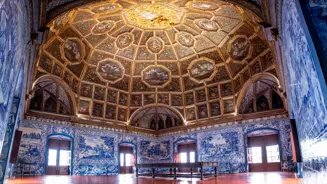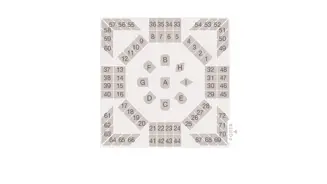Does your surname mark you out as a member of the 72 noble families specially chosen by King Manuel? Find out at the Royal Palace of Sintra
22 Feb 2024
When you step inside the Room of the Coats of Arms at the National Palace of Sintra, stop for a moment and look around you. Take in the beauty and details of this room, which is a prime example of Manueline influence in this palace (c.1515–1518). Look up and pay attention to the features. Can you see the symbols? How do they relate to Portuguese history? Are they merely decorative elements, or does each one have a specific meaning?
In fact, the ceiling of this room represents not only the royal family, but also the 72 most influential noble families in the kingdom. Even today, this 16th-century heraldic record remains of huge interest to Portuguese nationals and people of Portuguese descent from all over the world who are keen to find out whether they belong to one of the leading families in Portugal at that time.
But why only 72? The answer lies in a passage from the Bible (Luke 10: 1): – ‘After this the Lord appointed seventy-two other disciples and sent them two by two ahead of Him to every town and place where He was about to go [to spread the Good News]. (…) The seventy-two returned with joy and said, “Lord, even the demons submit to us in your name.” Jesus replied, “(...) Do not rejoice that the spirits submit to you, but rejoice that your names are written in heaven.”’ The choice of these 72 families was intended to highlight the Portuguese monarchy’s desire to spread the Christian faith throughout the world. These nobles were like disciples of the king, God’s representative on Earth. They were to carry out the monarch’s plans in his name.

The monarch at the centre
So which families are represented here? First of all, it is important to understand how this register of names was arranged.
At the top of the dome is the royal coat of arms, crowned with the winged serpent of the ruling dynasty of Avis. The monarch – in this case, King Manuel I (r.1495–1521) – was at the centre of everything and wanted to project his status. Manuel I was one of the richest monarchs in Europe. During his reign, Portuguese explorers reached Brazil and discovered the sea route to India. In fact, he was at the Palace of Sintra when he received news of these feats. But Manuel I had a weakness – he was not the son of a king. So that there would be no doubt as to his legitimacy as sovereign, he based his identity around his descent from his grandfather, King Duarte. The motto of King Duarte, “Tan ya serey” (which translates as “I will be loyal” or “I will work loyally”) appears between the antlers of the deer (a symbol of justice and Christ) on the king’s banners, which can be seen in the dome. Manuel also put his coat of arms at the centre of the decoration, thus projecting his role as Christ’s lieutenant on Earth, with his 72 disciples around him. He appears at the top of the social hierarchy, with all light emanating from him. Another interesting feature of the room’s design is that it grows increasingly darker as we move away from the crown of the dome (and thus the representation of the king) and get closer to the ground.
King Manuel had the coats of arms of his eight children with his second wife, Queen Maria (daughter of the Catholic Monarchs) painted around the royal arms. They represent his six sons (coats of arms on escutcheons) and two daughters (coats of arms on bipartite lozenges).
From Almeida to Vieira
On the lower level are the coats of arms or escutcheons of the 72 most important noble families in the kingdom. But what made them the most important and influential in Portugal? The coats of arms of members of the nobility generally refer to the exploits of their ancestors. In other words, a nobleman’s honour did not merely derive from his own actions, but from the deeds of his ancestors and close relations. The individual’s own story and family background thus dictated his influence. The inscription that runs around the room makes reference to the coats of arms on display and the dedication of these families to the Portuguese crown: “THROUGH THEIR LOYAL SERVICES HAVE THESE AND OTHER HONOURS BEEN EARNED, AND MUST THEREFORE BE PRESERVED.”

Based on this diagram, learn about the families represented in the Room of the Coats of Arms and their respective positions:
|
A – Armas do Rei B – Infante D. Yoam C – Infante D. Luis D – Infante D. Fernando E – Infante D. Afonso F – Infante D. Enrique G – Infante D. Duarte H – Infanta D. Isabel I – Infanta D. Beatriz 42 – Aboins 27 – Abreus 71 – Aguiares 23 – Albergarias 14 – Albuquerques 24 – Almadas 16 – Almeidas 15 – Andrades 66 – Arcas 4 – Ataídes 25 – Azevedos 58 – Barretos 55 – Bethancourt 72 – Borges 28 – Britos 35 – Cabrais 43 – Carvalhos 26 – Castelo-Branco |
3 – Castro (da Penha Verde) 7 – Castros 63 – Cerveiras 59 – Coelhos 32 – Corte-Real 45 – Costas 2 – Coutinhos 8 – Cunhas 5 – D’Eças 69 – Farias 18 – Febos Monis 61 – Ferreiras 53 – Gamas 65 – Góios 56 – Góis 68 – Gouveias 21 – Henriques 33 – Lemos 19 – Limas 49 – Lobatos 30 – Lobos 40 – Malafaias 17 – Manueis 38 – Mascarenhas 41 – Meiras 12 – Melos 22 – Mendonças |
36 – Mirandas 6 – Meneses 44 – Motas 29 – Mouras 54 – Nogueiras 1 – Noronhas 47 – Pachecos 10 – Pereiras 46 – Pessanhas 57 – Pestanas 64 – Pimenteis 67 – Pintos 60 – Queirós 34 – Ribeiros 31 – Sás 39 – Sampaios 62 – Sequeiras 52 – Serpas 13 – Silvas 48 – Soutomaior 9 – Sousas 37 – Tavares 20 – Távoras 50 – Teixeiras 51 – Valentes 11 – Vasconcelos 70 – Vieiras |
Next time you go to the National Palace of Sintra, open this article and discover which is your family’s coat of arms.
If you can't find your family name among the 72 chosen, don't be discouraged: King Manuel had António Godinho draw up the Book of Nobility and Perfection of Arms (c. 1521-1541), which became the heraldic reference for the 16th century. Consult the original pages of this document in the Torre do Tombo to see if your surname appears.
